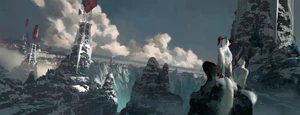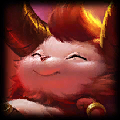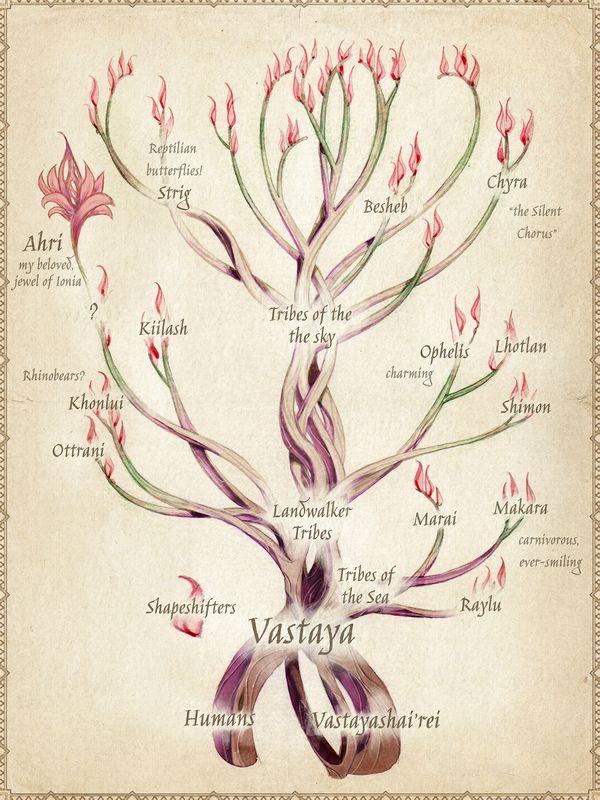
The Vastaya known as and
The vastaya are chimeric creatures of Runeterra whose lineage contains both human blood and the spiritual magic of a pre-human race. From the ferocious, bestial power of to the foxlike allure of , vastaya can look considerably different from one another, but they all share animal and human characteristics.
History

Vastaya overlooking trespassers

Fauhwoon Vastaya overlooking magic harvesting Quinlons.
The vastaya's origins can be traced back to a hidden corner of Ionia where a group of humans fled in escape of the Great Void War. There, these refugees came into contact with a tribe of intelligent shapeshifting creatures who were greatly in tune with the world's natural magicks. These spiritual creatures, known as the Vastayashai'rei, welcomed the human refugees and eventually produced what Runeterrans now refer to as vastaya - a blanket classification for any number of species of chimeric creatures. Over time, the varied offshoots began to settle in different regions and naturally adopted different forms - , avian, even - according to the creatures which most embodied their strongest characteristics.
In addition to their animal-human forms, vastaya are notable for their extremely long lives. Some have been known to live for thousands of years, while others claim to be immortal.
As time wore on and the vastayan bloodline spread throughout Runeterra, an interesting genetic aberration occurred: certain humans with very small amounts of vastayan heritage gained the ability to shapeshift. From the frozen Freljord to the darkest jungles of Runeterra, these shapeshifters can't maintain their animalistic forms for long, yet are still capable of harnessing some of their ancestral magic and change their shape.
There is a very old treaty between specific tribes of Ionian Vastaya and the humans that deals with the sharing of natural magic. However in recent decades, post-Noxian Invasion, the Vasstaya have become increasingly unhappy and uncertain with the way humans are using magic. Extremist groups like the Order of Shadows have begun consolidating power for their own purposes.
Biology
- For more information, see Vastaya Field Journal.
Vastaya are sexually dimorphic group of races of various shapes and sizes. Their animalistic appearance depends on the location in which they adapted. However, there are three distinct types of Vastayan appearances and natures:
- With very strong animalistic features. They closely resemble upward walking mammals which have largely animalstic features in their bodies design and behavior.
- With mild animalistic features. They closely resemble humans, but still retain a modest level of animalistic elements, most notable feline ears, or feathers. The facial characteristics are closer to human appearance than animalistic.
- Shapeshifters. They ether retain ether a human or animal appearance of their choosing, but they are able to shapeshift in and out of each forms.
Each type of Vastaya greatly differ from one another in appearance and abilities, but all of them are in tune with the natural magics of the world in various degrees. Some are born in the race (or have ancestral ties to the race and have Vastayan traits manifested), while a rare few are magically altered to become one of three types types of Vastaya. The race has far longer life spans than humans. Some have been said to live for thousands of years, while others, rumors and legends say, might be immortal.
Having Vastayan heritage is not the same as being a Vastayan. A true vastayan can live in the mortal world, but not for very long without access to magic. A true vastayan can also live in the spirit realm, but not for very long without a material form to contain them. The ancient ones were born in the borders between mortal and spirit realms. Long ago those borders were less distinct and more common.
Furthermore, many creatures gain power from the spirits' realms in other ways. Vastayan and creatures with the Vastayan heritage have a common ancient ancestor born from between mortal world and the spirit world. This means they are born with a natural magical connection to natural magicks. Others creatures and magic users have stolen this magic or taken it from the spirit world but they are not vastayan and do not even have that heritage.
Races
There are three main Vastayan tribes (sea, landwalker, and sky) each with their own sub-tribes:
- Tribes of the Sea
- Marai (most notable member being )
- Makara
- Raylu
- Landwalker Tribes
- Unknown humanoid foxes (most notable member being )
- Fauhwoon
- Juloah (notable similarities to Lhotlan, but they are hairy rather than feathered)
- Kiilash (most notable member being )
- Khonlui
- Ophelis
- Ottrani
- Lhotlan (most notable members being and )
- Shimon (most notable member being )
- Sodjoko (a mashup tribe of various different type of Vastaya)
- Tribes of the Sky
- Besheb
- Chyra
- Strig
- Numerous other currently unknown tribes
Culture
Not much is known about their culture due to the mysterious nature of this race. However, like their biological nature, their culture is a mix of both animalistic and human behavior which reflects both in the races individuals interaction with other sentient and non sentient beings. Their culture is also heavily shaped by the location each type of Vastaya live in.
The Marai Vastaya have cultural and existential ties with Mount Targon. The Moonstone protects its people from monsters from the dark depths of the Guardian's Sea. However, the moonstone needs to be replenished over time, so a Tidecaller of each generation is tasked to retrieve a new one from the contemporary vessel for the Targonian Aspect of the Moon.
The Kiilash Vastaya have cultural and existential ties with Shurima. Their entire society revolves around the honor and glory of the hunt. Due to Shurima having a wide infestation of Voidborn creatures, the Killash see them as one of the most venerated and sought after prey.
The Lhotlan Vastaya have cultural and existential ties with Ionia. Being one of the oldest Vastayan tribes in existence, they have deep ties with their ancestral roots and protect their cultural heritage from the ever encroaching human population of the continent.
The Shimon Vastaya have cultural and existential ties with Ionia. These apelike Vastaya are a wise, cautious people, and as pacifists, chose to build their society away from landwalkers, cultivating their society atop the tallest trees in Ionia. The Shimon see life as an evolutionary climb to wisdom, thus upon death, the Shimon believe they become stones, returning to the soil to begin the climb of life again.
Vastaya speak their own language, linguistically unrelated to various languages spoken by humans:
- Vastayan basic word-order is subject-object-verb.
- Vastayan is a predominantly agglutinative language, which forms words by combining morphemes, yet the morphemes often remain unchanged; e.g. vi "wild" & om "magic" becomes vi-om "wild-magic".
- Vastayan has at least two grammatical genders: masculine & feminine.
- Interestingly, Vastayan grammar allows grammatical tenses to be affixed onto pronominal subjects, just like many real-life languages.
Just as each human language consists of many dialects, so does Vastayan language: for instance, the Baraashi dialect is spoken by the Lhotlan tribe of and .[1]
(Baraashi was created using elements from the real-life Finnish & Arabic languages as its basis.)
- Vastaya Baraashi dialect (Lhotlan Tribe)
- Baasi - I (future tense).
- Eli, Ella - Love (masculine, feminine).
- Faash - They (present tense).
- Ighilya - Great Grandmother.
- Iminha - Little One.
- Mi - My.
- Mieli, Miella - My Love (masculine, feminine).
- - A slang for "Blood traitor".
- Na - To not be.
- Om - Magic.
- - Farewell.
- Soura - To Gather.
- - Rest in peace/well.
- Tann - Here.
- Va'h - To be (present tense).
- Vastaya - Vastaya (the people).
- Vi - Wild.
- Vi-om - Wild-magic.
Trivia
- In-universe, the appellation Vastaya means simply "[the] people" & is shortened from their supernatural ancestors' endonym Vastayashai'rei.
- The tribal name Makara was probably inspired by the eponymous aquatic monster मकर < Proto-Dravidian *mokaray "crocodile" < *mok-/*moṅku- "to devour"[2].
- Other names might've originated from human languages, due to Vastayans' partial human ancestry, e.g. Marai < "mere (sea)", Ophelis < "ὠφελειᾱ (help)" or unrelated "ὄφῐς (snake)", Ottrani < "otter".
- Vastaya greatly resemble Yordles in the sense that both are animalistic in appearance and both have a strong connection to magic.
- is annoyed that humans mistakenly label Yordles as Vastayan.
- The true existence and fate of the Vastaya were unknown to western scholars until an explorer from Piltover, Eduard Santangelo, chronicled his findings of this mysterious race during his expedition to the magically infused continent. Upon first encountering them, he coined the term 'Phantasma', but later adopted the local name for them.
- Santangelo mentions examples of Vastaya ranging 'from the winged humanoids of Ionia or the sporadically-limbed sandshufflers of Shurima, to the Freljordian scaled manatee with a look of perpetual discomfort on its face'.
- Chem Tech transformation may have been inspired by the Vastaya and their chimeric existence (which might have discovered when participating in Noxus' Ionian Campaign)
- Despite sharing Vastaya racial features, was a plague rat that was transformed by chemical waste and is not a Vastayan.
- and might be species of Vastaya within the Vastaya taxonomy, however Xayah does not recognize them as such in her voice lines.
- On the Summoners Rift, the red team's shopkeeper is most likely to be a Vastayan.
- Some of the Vastaya resided in the sacred grove of Omikayalan, the Heart of the World. In its center stood the God-Willow. This massive tree, dripping with long gossamer leaves that shimmered with golden-green light, was of immense importance to both Human Ionians and the Vastayan people of the continent, which guarded the tree from anyone who wished it harm. Unfortunately, the tree was destroyed by an invading war party from the Freljord, its leader transformed by its natural energy into the being known as .
Notable Vastaya
| Vastayan Champions | Place of Birth & Occupations |
|---|---|
| Ionia; Enchantress of Ionia | |
| Mount Targon's Guardian's Sea; Marai Tidecaller | |
| Ionia; Lhotlan freedom fighter | |
| Shurima; Kiilash Trophy hunter | |
| Ionia; Lhotlan freedom fighter | |
| Ionia; Shimon Wuju disciple |
Notable Half-Breed Vastaya
These champions are not considered true Vastaya, but do have some Vastayan blood from the group ether by being diluted descendants of Vastaya or being given / taken the blood. All notable members have some form of animalistic shapeshifting abilities.[3]
| Vastayan Champions | Place of Birth & Occupations |
|---|---|
| Unknown; Kumungu Huntress; Human given Vastaya blood or a Vastaya descendant | |
| Noxus; Grand General of Noxus; Human modified by , possibly Vastaya'shairei. | |
| Freljord; Spirit monk; Human given Vastaya blood |
See Also
References
- ↑ Vastayan Baraashi dialect
- ↑ N. Ganesan, A Dravidian Etymology for Makara - Crocodile, p. 7
- ↑ Vastaya Q & A
Template:Races

